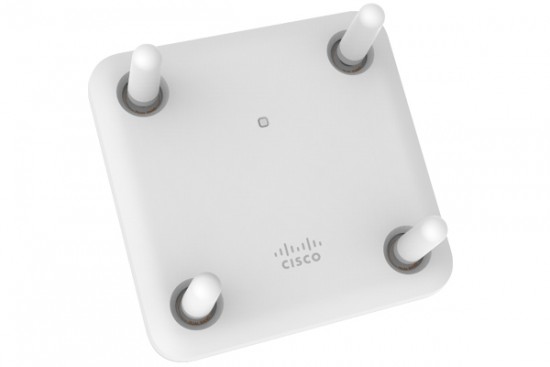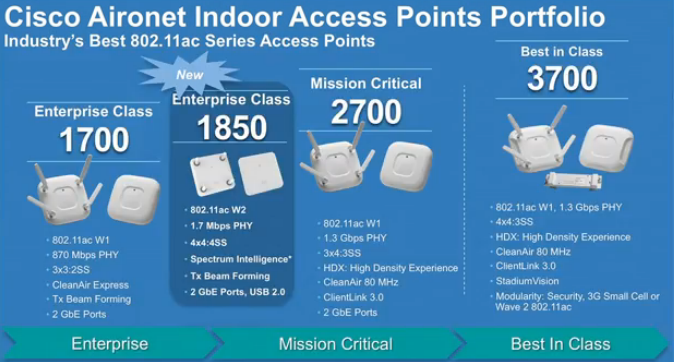
The first 802.11ac Wave 2 access point-Cisco Aironet 1850 Series was introduced last week in the Cisco Live in San Diego. It is the first Access Point to support the latest Wi-Fi standard 802.11ac Wave 2.
The introduction of 802.11ac Wave 2 marks the first time that Wi-Fi has the throughput ability to move beyond the 1Gps barrier. The significance in not only because this is a nice large number but as the adoption of Wave 2 devices grows, Wi-Fi bandwidth will exceed the capacity of the wired infrastructure.
That Cisco Aironet 1850 Series Access Point, due to ship in July, can offer users a data rate of 1.7Gbps using both of the main Wi-Fi frequency bands. It can also transmit to three users at a time so they don’t have to share time on the network. That’s far short of what 11ac Wave 2 will ultimately deliver, with a theoretical speed of 6.8Gbps, but a big step up from Wave 1, which tops out at 1.3Gbps.
But the 1850 Series AP doesn’t come with the new multigigabit Ethernet ports that are expected to help make Wave 2 Wi-Fi reach its potential. Instead of the new interfaces that can operate at 2.5Gbps or 5Gbps, the new Cisco APs come with two regular Gigabit Ethernet ports.
The 1850 Series is designed for medium-size customers or the lower end of large enterprises. The size of their deployments and the density of use at their sites isn’t likely to generate more than 2Gbps of uplink traffic through the AP, Cisco said.
The APs will balance the traffic load between the two Gigabit Ethernet ports to take advantage of their combined capacity, Cisco says. However, making that work would require two Ethernet cables out to the AP.
What are the main features of the new Aironet 1850 Series? Let’s check what the Aironet 1850 Series can offer customers:
Flexible deployment modes.
- Controller-based deployments support small and medium networks
- Integrated and external antenna models are available for various deployment environments
Better Wi-Fi coverage and performance with the latest Wi-Fi technology.
- Supports 802.11ac Wave 2 (dual radio, 80 MHz channel size) and 4X4 MIMO
Improved client performance with multi-user multiple input and multiple output (MU-MIMO).
- Get MU-MIMO with three spatial streams for 802.11ac Wave 2 clients
- Transmit beam-forming for a better client experience
Fast offload to a wired network.
The 1850 Series provides two Gigabit Ethernet ports to support Link Aggregation Group (LAG).
NEW Cisco Aironet 1850 Series Access Points-Specifications at a Glance
| Key Features | Details |
| Wi-Fi Standard | 802.11ac Wave 2 |
| Radios | Dual 2.4 GHz and 5 GHz, up to 80 MHz maximum bandwidth |
| Maximum PHY data rate | Total aggregate maximum PHY rate = 2021 Mbps
|
| MIMO radio design: spatial streams | 2.4 GHz: 3×4:3SS SU-MIMO 5 GHz: 4×4:4SS SU-MIMO, 4×4:3SS MU-MIMO |
| Max. associated clients | 200 per radio, 400 maximum per access point |
| Beamforming | Transmit beamforming |
| Interfaces |
|
Cisco Aironet Indoor Access Points
Compare Cisco Aironet 802.11ac G2 Series Indoor Access Points
| Cisco Aironet 802.11ac G2 Series Indoor Access Points | 1700 Series | 1850 Series | 2700 Series | 3700 Series |
| Wi-Fi standards | 802.11 a/b/g/n/ac | 802.11 a/b/g/n/ac (Wave 2) | 802.11 a/b/g/n/ac | 802.11a/b/g/n/ac |
| Ideal for | Small and midsize enterprises | Small and midsize enterprises | Midsize or large enterprises that require advanced features | Midsize or large enterprises that require mission-critical traffic |
| Site type | Small and midsize offices, schools, warehouses | Small, Midsize office, school or warehouse | Midsize office, school or warehouse | Large office, midsize, or large warehouse |
| Application performance profile | 802.11ac migration | 802.11ac migration | High client density environments 802.11ac migration |
High client density HD Video/VDI 802.11ac* migration Comprehensive security |
| Future-proof modularity | N/A | N/A | N/A | Yes WSM or 3G Small Cell or 802.11ac Wave 2* Module |
| Crowded areas | Yes | Yes | ||
| Number of radios | Dual (2.4 GHz and 5.0 GHz) | Dual (2.4GHz and 5.0GHz) | Dual (2.4GHz and 5.0GHz) | Dual (2.4GHz and 5.0GHz) |
| Max data rate | 867 Mbps | 1.7 Gbps | 1.3 Gbps | 1.3 Gbps |
| MIMO radio design: spatial streams | 3 x 3:2 | 4 x 4:4 (SU-MIMO), 4 x 4:3 (MU-MIMO) |
3 x 4:3 | 4 x 4:3 |
| Client count/ClientLink client count | 200/- | 200/(n/a) | 200/128 | 200/128 |
| Autonomous access point option | Yes | No | Yes | Yes |
| ClientLink 3.0 | Transmit beamforming with 802.11ac clients | Transmit Beam forming (Tx BF) | ClientLink 3.0, adding 802.11ac support for enhanced connectivity with 802.11 a/g/n/ac clients ECBF with 802.11ac clients ClientLink 3.0, adding 802.11ac support for enhanced connectivity with 802.11a/g/n/ac clients |
ClientLink and ECBF to 11ac clients concurrently ECBF with 802.11ac clients ClientLink and ECBF to 11ac clients concurrently |
| CleanAir 2.0 | CleanAir Express — with 80 MHz channel support | Spectrum Analysis* | Yes — with 80 MHz channel support | Yes – 80 MHz channel support |
| GPS | ||||
| Backhaul | ||||
| DOCSIS3.0 capability | ||||
| LTE Coexistence | ||||
| VideoStream | Yes | Yes | Yes | Yes |
| BandSelect | Yes | Yes | Yes | Yes |
| Rogue access point detection | Yes | Yes | Yes | Yes |
| Adaptive wireless intrusion protection system (wIPS) | Yes | Yes | Yes | Yes |
| OfficeExtend (Integrated- antenna models only) |
Yes | Yes* | Yes | Yes |
| FlexConnect | Yes | Yes* | Yes | Yes |
| Power | 802.3af, 802.3at PoE+, Enhanced PoE | 802.3at PoE+, Enhanced PoE 802.3af (reduced capabilities) |
802.3at PoE+, Enhanced PoE | 4 x 4:3 operation: 802.3at PoE+, Enhanced PoE, Universal PoE (UPOE) 3 x 3:3 operation: 802.3af PoE |
| Temperature range | 1700i: 0 to 40°C | 1850i: 0 to 40° C 1850e: -20 to 50° C |
2700i: 0 to 40° 2700e: -20 – 50° C |
3700i: 0 to 40°C 3700e: -20 to 55°C 3700p: -20 to 55°C |
| Antennas | 1700i: Internal | 1850i: Internal 1850e: External |
2700i: Internal 2700e: External |
3700i: Internal 3700e: External 3700p: External |
| Limited lifetime warranty | Yes | Yes | Yes | Yes |
*Planned for future support
More Topics Related to Cisco Wireless Access Points
Why You Should Upgrade with Cisco 802.11ac Solution?
Cisco Aironet 802.11n G2 Series Indoor Access Point Comparison
New Cisco Aironet 2700 AP vs. AP3700
Cisco Aironet 1700 Series-Entry-Level 802.11ac Access Points







